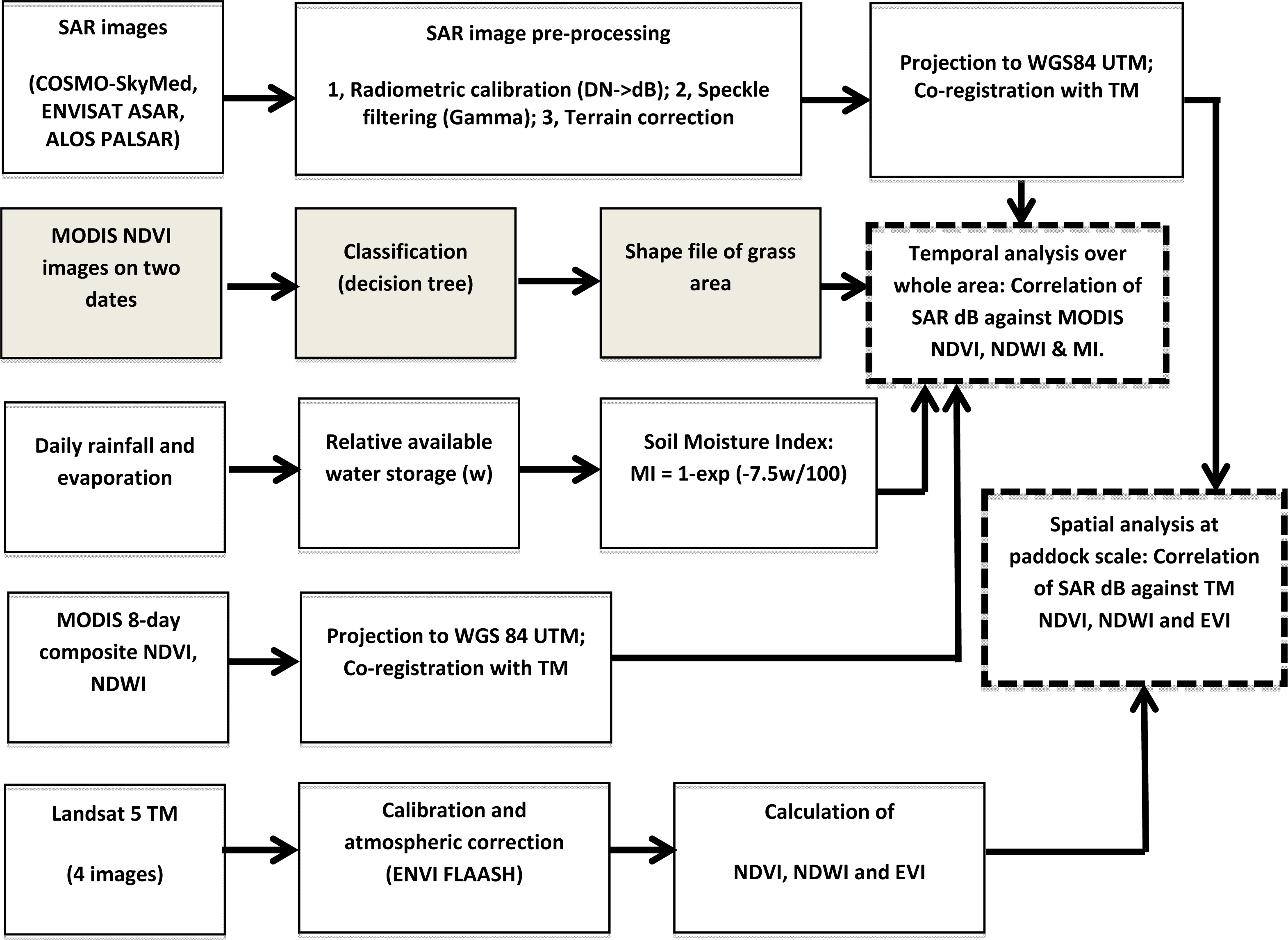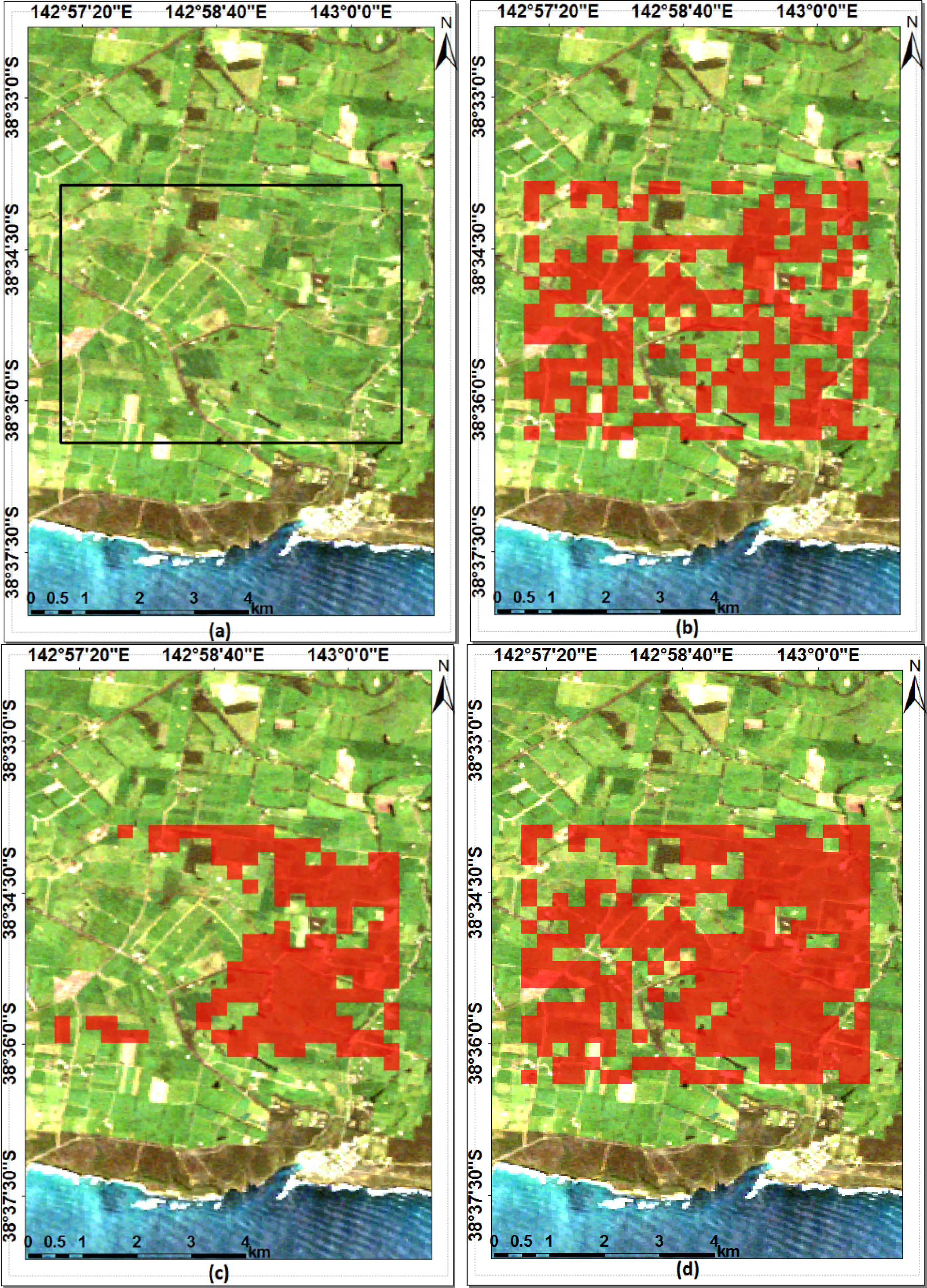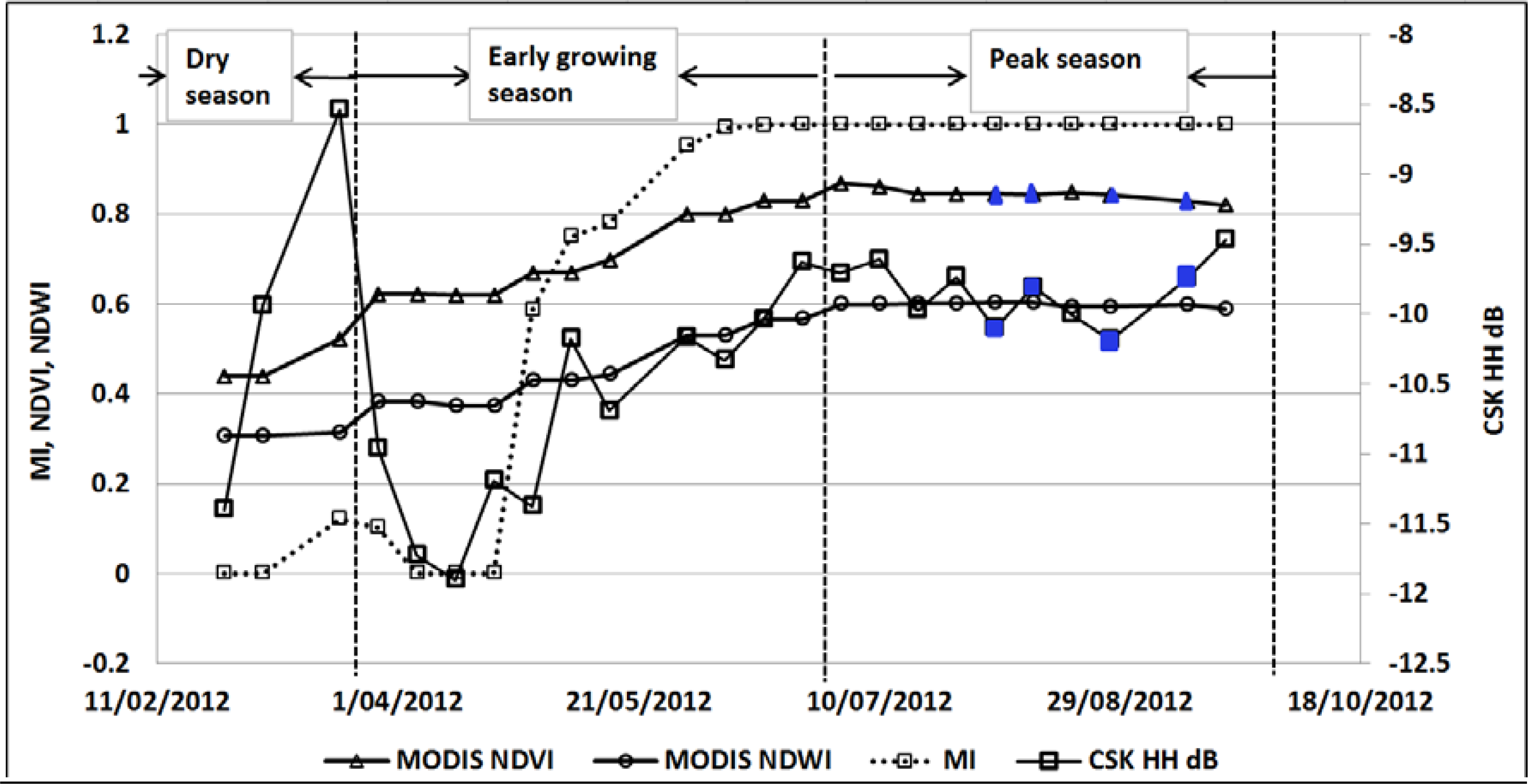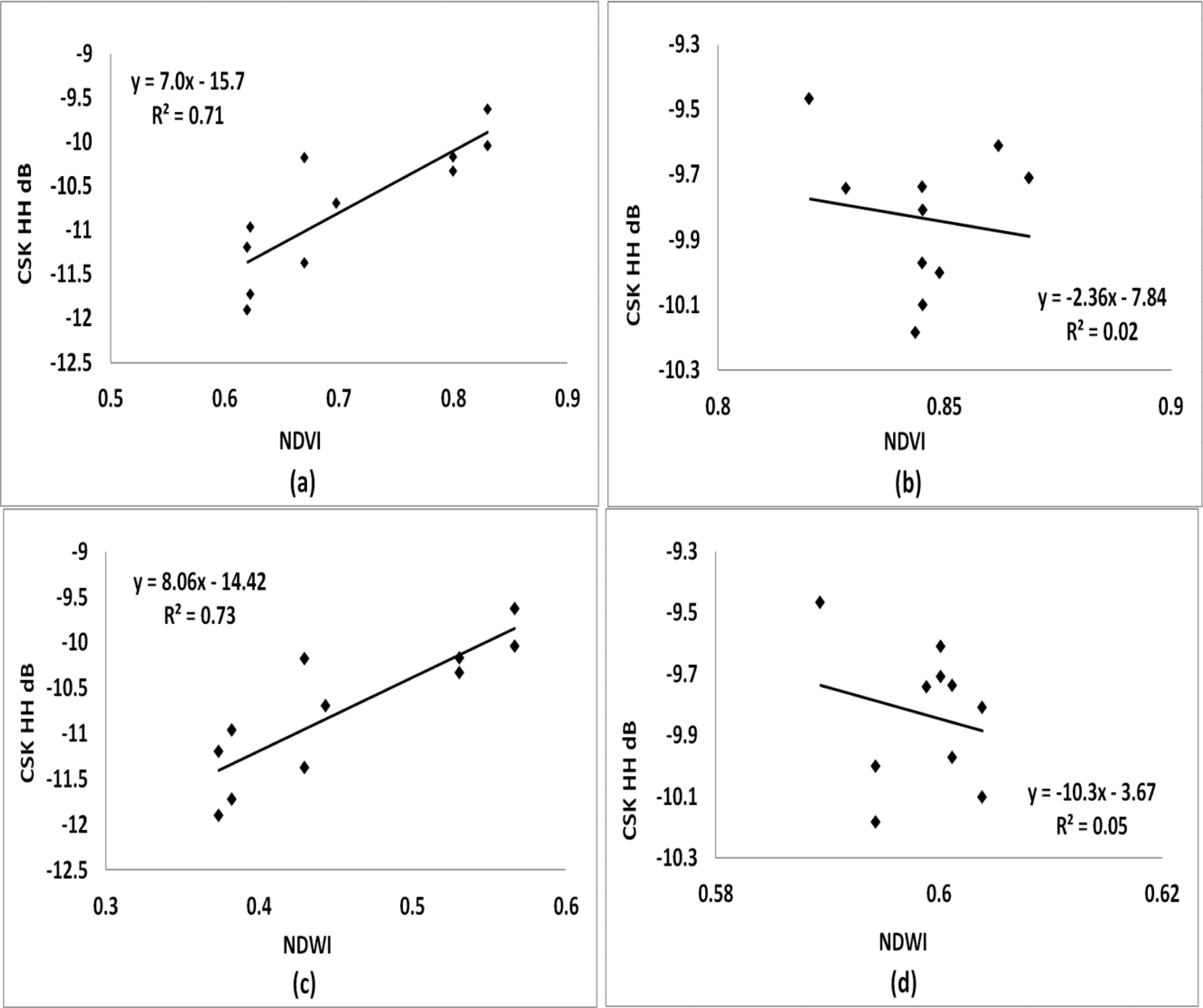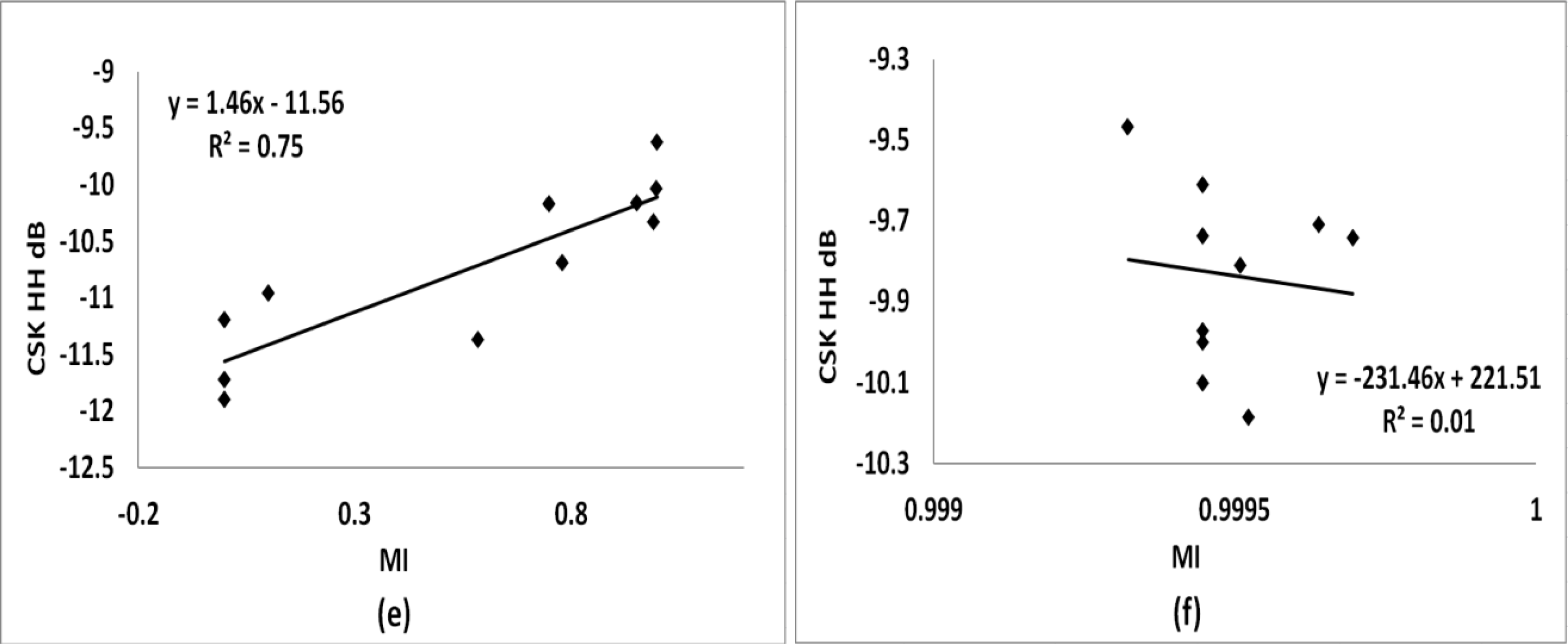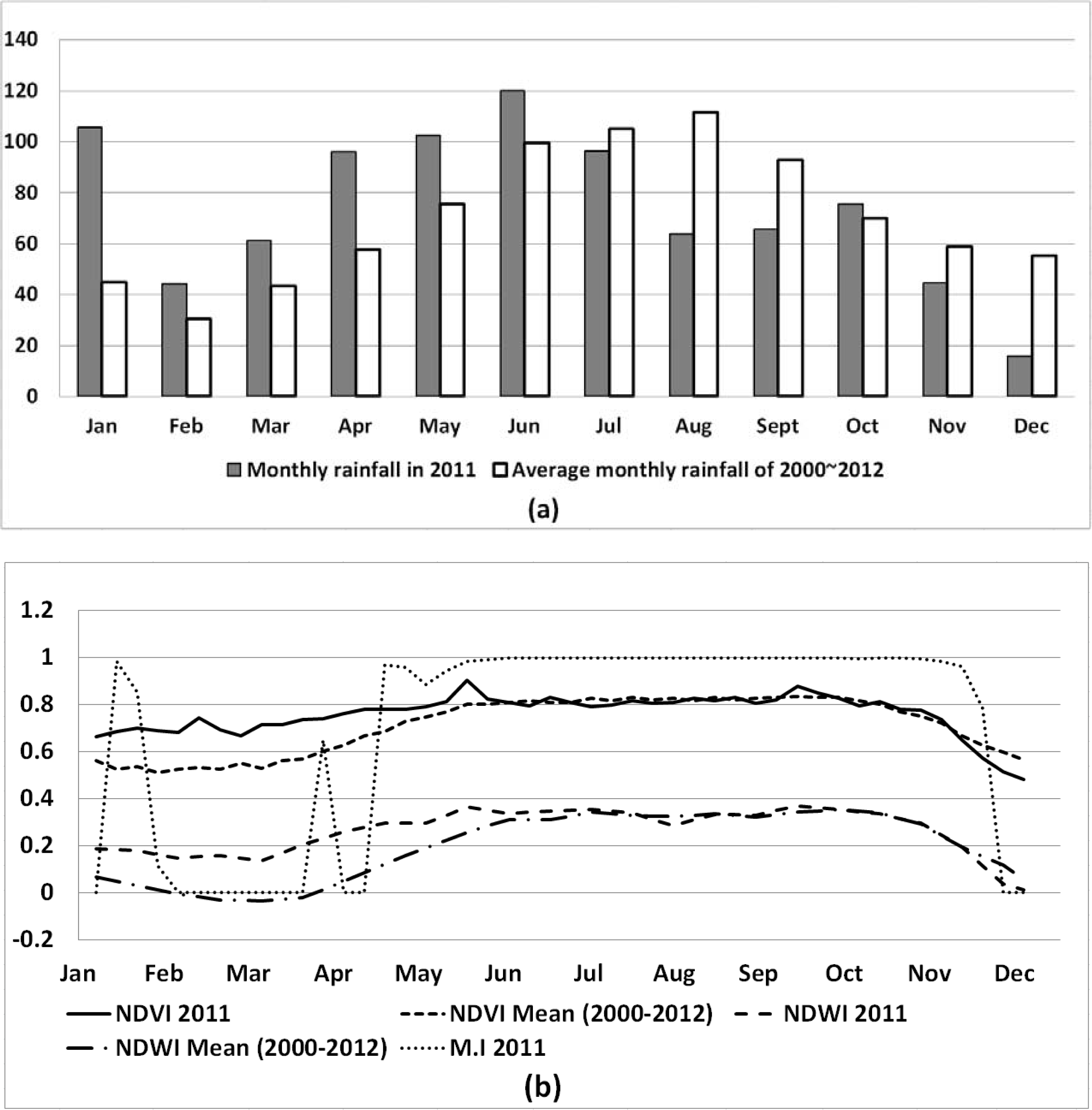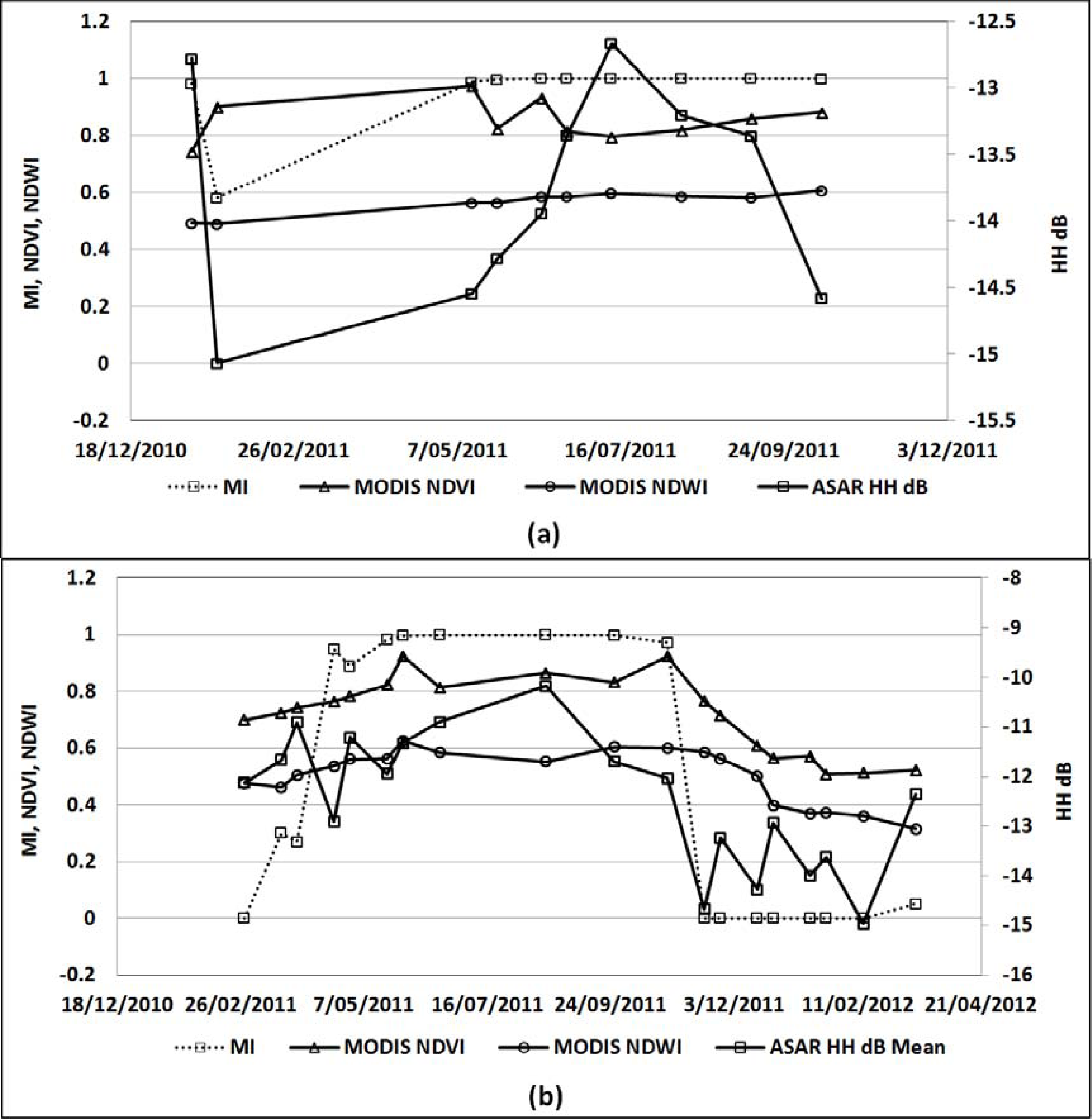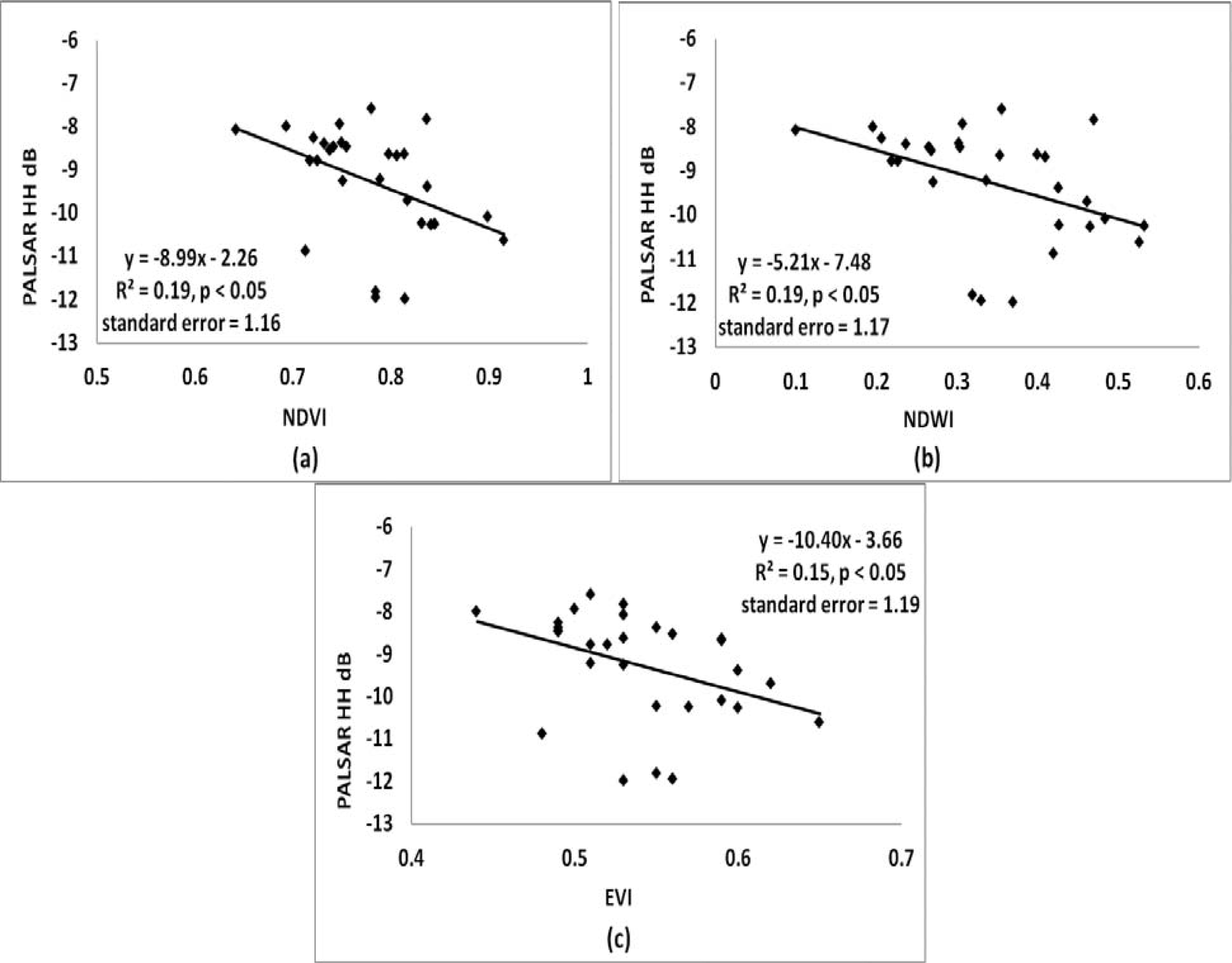1. Introduction
Pastures represent one type of managed landscape units in the terrestrial system. Pastures are essential contributors to the productivity and biodiversity of the biosphere, supporting domesticated livestock as a key component of ecosystem. Good pasture management and optimal feed use are, therefore, important for sustainability of the ecosystem as well as prosperity of pasture. Improved utilization of pastures can be achieved by implementation of intensive rotational grazing mechanisms. Rotational grazing involves controlled movement of herds, from paddock to paddock, according to the amount of available biomass or feed in both the current and the destination paddock. A paddock is a small field of grassland, normally fenced and separated by farmers for keeping sheep or cattle. In these intensive grazing systems, pasture biomass must be regularly estimated at the paddock scale for better grazing rotation. Paddocks with higher biomass may be used to lengthen the grazing interval while paddocks with lower biomass should be allowed more time to grow to the desired mass. Traditional biomass estimates are done by using a rising plate meter to measure grass height and convert to biomass. The process is time consuming, requires field work skill, and is limited to single transect [
1].
The space borne remote sensing images are used for measuring and mapping pasture biomass, because of its capacity of providing repeated observations over a large area. Using multispectral optical images, the seasonal pattern of Normalized Differential Vegetation Index (NDVI) has been used for classification of grassland in North America [
2] and Eastern Australia [
3]. NDVI has been widely used for estimation of grass biomass [
4,
5]. The “Pastures from Space” project in Western Australia was aimed to provide biomass information from Moderate Resolution Imaging Spectroradiometer (MODIS) data at the paddock scale [
6,
7]. However, with the 250 m spatial resolution, it cannot provide biomass information for a whole paddock because of unavailable mixed pixels in between paddocks. Various vegetation indices from 30 m resolution Landsat Thematic Mapper (TM) imagery were used for pasture biomass in Central Italy, and it was found that NDVI provided the most accurate estimation for grass biomass [
5]. Landsat TM images were employed to estimate pasture biomass at the paddock scale in Western Australia [
8], but it is difficult to deliver high temporal resolution (weekly and/or daily) information because with low repeating frequency (16 days), and cloud interference, it will be up to one month without data. Therefore, high-resolution Synthetic aperture radar (SAR) and Landsat TM could be combined for pasture biomass estimation in order to deliver information with high temporal and spatial resolution. SAR data was combined with NDVI for cereal yield modeling in Finland, only for validation, while the study was focused on using NDVI for yield estimation [
9].
NDVI is able to stand for biomass, but cannot describe plant water content accurately. The Normalized Difference Water Index (NDWI) is commonly used as an accurate estimate of plant water content [
10]. It has been successfully applied to the remote detection of plant water content for grasslands [
11]. Enhanced Vegetation Index (EVI) is an “optimized” index designed to enhance the vegetation signal with improved sensitivity in high biomass region, and it is also an improvement of vegetation monitoring through de-coupling of the canopy background signal and a reduction in atmospheric influences [
12,
13]. While the NDVI is chlorophyll sensitive, the EVI is more responsive to canopy structural variations, including canopy type, plant physiognomy, and canopy architecture. While these optically based studies show promise for pasture monitoring, they are always hampered by cloud conditions and night. This has led to our interest in integrating radar techniques with the multispectral optical indices for pasture monitoring research.
SAR work with microwaves that can penetrate clouds [
14]. Furthermore, a change in moisture content of grass and soil generally provokes a significant change in their electric properties which influence the absorption, transmission, and reflection of microwave energy. Thus, apart from the height of grass, the moisture content of grass and soil will influence the reflected energy from grassland [
15,
16]. Nevertheless, investigations on grasslands by using SAR technology are not as intensive as on crops and forests. There are generally two methods for retrieval of vegetation parameters: the physical scattering model and empirical model. As far as the physical scattering model is concerned, in the past 30 years, direct scattering models have been developed from water cloud [
17] and the Oh model [
18] to the radiative transfer model [
19,
20], and the complicated Integral Equation Method (IEM) [
21,
22]. However, the mathematical formulation of these models is complicated and makes a direct inversion difficult. Then, on the basis of statistical approaches, such as neural network, some promising results were obtained for inversion of soil moisture [
23] and plant water content of crops [
24]. It needs to be pointed out that, for scattering models, a complete ground truth database, concurrent to radar acquisitions, need to be built up. Moreover, the spatial variability of the soil and vegetation properties, from one locality to another, complicates the application of the modeling. Thus, it is more suitable for using these models’ parameters for larger areas than a paddock. A paddock is small and its vegetation variation is significantly affected by human activities such as grazing and mowing.
When it comes to empirical modeling, very few researches were directly carried out for grass biomass or water content. A correlation was found between the C-band (ERS) VV backscatter density and grass height, and due to the fact that the plant height correlates with the biomass, the grass biomass can be estimated indirectly [
25]. ERS VV backscatter was sensitive to biomass of totora reeds and bofedal grasslands in wetland, and this sensitivity was highly related to the underlying water surface or water-saturated soil [
16]. The other studies involving grass focused on classification, where grass was one of the several ground cover classes. For example, the potential of airborne SAR has been explored for grassland classification, using relationships between mean herbage height and C- and L-backscatter in grassland in New South Wales, Australia [
3]. The results suggest that combined imagery from C-and L-band satellite-borne SAR sensors have potential for current application in grassland monitoring. To assess the capability of satellite C-band and L-band for pasture monitoring, Environmental Satellite Advanced Synthetic Aperture Radar (ENVISAT ASAR) and Advanced Land Observing Satellite Phased Array type L-band Synthetic Aperture Radar (ALOS PALSAR) will be used in this study in Otway, Australia.
The use of X-band is expected to be appropriate for pasture biomass, since the scale of pasture and the wavelength is comparable [
1,
26,
27]. However, very limited studies regarding pasture were carried out, and few consistent results were found. For example, in pasture areas in New Zealand, TerraSAR-X HH+HV backscatter performed the best among all polarization combinations, with a residual standard error of 317 kg/ha [
28]. In contrast, when using TerraSAR-X dual polarization (HH/VV) for pastures in Queensland, Australia, R
2 of relationship between SAR backscatter and individual variables (biomass, soil moisture, and roughness) was too low, indicating that the vegetation, as well as the soil surface, contribute to the net backscatter [
29]. In a study of nature conservation sites in the Alpine region [
30], the data of COnstellation of small Satellites for the Mediterranean basin Observation (COSMO-SkyMed) was used, and it was found that the potential of VV backscatter to detect grazing or mowing activities was undermined by rainfall events, which made backscatter signal increase sharply. The COSMO-SkyMed (CSK) system, with its four identical constellation satellites, is capable of acquiring frequent images at a high spatial resolution of one meter, twice a day. Thus, the temporal and spatial variation of SAR backscattering with grass growth is worth investigation using CSK data. Moreover, to our knowledge, pasture monitoring using CSK X-band time series images at HH polarization has not been done. Therefore, HH polarization of CSK, together with ENVISAT ASAR and ALOS PALSAR, will be a good opportunity to offer to the community of pasture biomass research.
The combination of SAR images at three different frequencies and the large amounts of SAR images are an added value of this study of pasture monitoring. However, it is very difficult and costly to collect a large amount of ground data corresponding to SAR at each paddock, on 77 dates, for modeling between field measurements and SAR signal. To lower the costs, the research in this paper was conducted by relating SAR signal to spectral vegetation indices (NDVI, NDWI, and EVI) as well as soil moisture index (MI), to study how SAR backscatter changes following pasture properties. NDVI and NDWI, obtained from MODIS and Landsat TM, are substitutes of biomass and plant water content, respectively, while MI is a proxy of soil moisture. Unlike the traditional regression model between ground data and SAR signal, this method proposed herein is a cost-effective and original way to investigate the potential of SAR data for pasture biomass monitoring.
The first objective of this research is to observe the variability of X-, C-, and L-band SAR signals corresponding to grass growth and grazing activities in the whole study area, with the assistance of MI and MODIS NDVI and NDWI. The second objective is to investigate the potential of using SAR to estimate paddock-by-paddock variations of pasture biomass and plant water content on certain dates, with the correlation of Landsat TM vegetation indices NDVI, NDWI, and EVI. The Landsat TM images are generally sparser due to low revisit frequency (16 days per cycle) and clouds and, thus, cannot be used for time series analysis. However, its higher spatial resolution of 30 m makes it capable of doing spatial analysis at the paddock scale on limited imaging dates.
2. Methodology
The objective of this study is to investigate the capability of CSK, ENVISAT ASAR, and ALOS PALSAR at HH polarization for pasture monitoring, thereafter to integrate SAR with optical images to shorten the revisit interval to approach near real-time observation of pastures at the paddock scale. To achieve this, the relationship of SAR backscattering coefficient was performed against optical vegetation indices (NDVI, NDWI), as well as soil moisture index (MI), which were obtained simultaneously to SAR data and used to assist our understanding of the potential of SAR for pastures.
As discussed in Section 1, for pasture monitoring at the paddock scale, the Landsat TM dataset is far better than MODIS’ due to the higher spatial resolution. On the other hand, considering the long revisit interval of the Landsat satellite, using frequent MODIS imagery for temporal analysis is essential. Additionally, annual grass growth pattern of a large region can be obtained from MODIS and used as a reference to benchmark the individual paddocks. Therefore, classification with MODIS images is required to extract grass zones from the whole study area, before further correlation analysis. The following paragraph describes the three main steps of data analysis.
As presented in
Figure 1, classification was first carried out using decision tree method over two MODIS NDVI images to extract the grass-only area from the study site. Then, over the grass area defined with the shapefile of the classification result, the time series of MODIS NDVI and NDWI, together with MI, were correlated with SAR HH backscattering coefficient (dB) to explore the potential of SAR in assessing temporal changes of grass biomass, water content, and soil moisture. Finally, Landsat TM NDVI, NDWI, and EVI of 29 paddocks were related to SAR HH backscatter to evaluate SAR’s potential for paddock-by-paddock variation of grass properties. This was conducted on two SAR imaging dates only, due to limited availability of corresponding Landsat TM images. Before the data analysis, pre-processing of optical and SAR data is necessary (see
Figure 1).
2.1. Study Site and Data
Figure 2 shows the study area (around 5 km × 5 km) in the Otway region, Southwest Victoria, Australia. Otway is one of the wettest parts in Victoria State. Grazing and dairy farming is an important signature of agriculture activity in this region. The annual dryland pasture zones in Otway are characterized by a distinct growing season, with a well-defined beginning and end. The season begins between April and June, depending upon the timing of the first significant rains, and ends in October or November. There was excessively plentiful rainfall in the dry season from the end of 2010 to the beginning of 2011, and consequently grass in the study area is presumed to stay green during that period.
MODIS eight-day composite NDVI images with 250 m resolution, during 13 years, from 2000 to 2012, were provided by the Department of United States Agriculture. These MODIS datasets are offering us the opportunity to derive the grass annual growth pattern. There are two Landsat images in the USGS archive that can be used to synchronize with SAR images to further analyze individual paddock’s biomass with a resolution of 30 m. The first Landsat 5 TM image was acquired on 19 October 2011, and matched up with ENVISAT ASAR image on 18 October 2011. The second Landsat 5 TM image was collected on 30 August 2007, corresponding to ALOS PALSAR image dated on 27 August 2007. Furthermore, the historical rainfall and evaporation data were obtained from the meteorological station Port Campbell Post Office (Station number: 90067, Lat: 38.62°S, Lon: 142.99°E).
For SAR data, twenty-four X-band COSMO-SkyMed HH Stripmap images were acquired in 2012 with high temporal resolution (around eight days), and twenty-one of them were in growing season. The incidence angle was 30.5° on average in study area. The images were projected after pre-processing with pixel size of 15 m × 15 m. Following this, ten C-band ASAR Image Single Look Complex (IMS) HH images were obtained with incidence angle 33°, nine scenes with incidence angle 17°, ten scenes with incidence angle of 21°, and one image with an incidence angle of 24.5°. Finally, twenty-three scenes of L-band ALOS PALSAR Fine Mode Single Polarization (FBS) HH images, during 2007–2010, were acquired, and 10 of them were in growing season. The incidence angle was 34.3°. The pixel size of C- and L-band SAR images was 30 m × 30 m after image pre-processing.
Table 1 is the list of all SAR images in details.
2.2. Synthetic Aperture Radar (SAR) Image Pre-Processing to Get Backscattering Coefficient (dB)
The SAR backscattering coefficient (sigma naught, dB) intensity image was obtained from single look complex (SLC) data through three steps of image processing, including radiometric calibration, spectral filtering and terrain correction. The NEST software, free software developed by the European Space Agency (ESA) for research, was used for this study. SAR data processing, which produces SLC images, does not include radiometric corrections and significant radiometric bias remains. It is therefore necessary to apply the radiometric correction to SAR SLC images so that the pixel values of the SAR intensity images truly represent the radar backscatter of the reflecting surface. Accurate calibration is also very important when multi-temporal data are used for applications. SAR intensity images have speckles that degrade the quality of the images and make interpretation of features more difficult. Speckle noise reduction can usually be addressed by adaptive filtering, and the Gamma Map filter is used here [
31]. Due to topographical variations of a scene and the tilt of the satellite sensor, distances can be distorted in the SAR images because of the side-looking geometry of SAR images. Terrain corrections are intended to compensate for these distortions. Range Doppler ortho-rectification method [
32] was used for geocoding SAR intensity images, and SRTM DEM with a three second resolution was used for terrain correction, and the ortho-rectified image was resampled with bilinear interpolation from the original to the final pixel size needed.
2.3. Calculation of Normalized Difference Vegetation Index (NDVI), Normalized Difference water index (NDWI) and Enhanced Vegetation Index (EVI)
It is necessary to remove atmosphere effect using the FLAASH tool in ENVI software after calibrating these Landsat TM images.
NDVI has been widely used for vegetation application, and the calculation of NDVI is as follows [
33]:
where Red and NIR stand for the spectral reflectance in the red and near infrared regions, respectively.
As for NDWI, the combination of the NIR with the Short Wave Infrared (SWIR) removes variations induced by leaf internal structure and leaf dry matter, and improves the accuracy in retrieving the vegetation water content [
10,
34]. The equation of NDWI is as follows:
The computation of EVI is as follows [
12]:
where Blue stands for the spectral reflectance of blue regions.
2.4. Soil Moisture Index (MI) Estimated from Climate Data
Soil moisture index (MI) was computed based on water balance process (
Equation (4)). MI scales the soil water availability between wilting point and field capacity to an index between 0 and 1.0 [
35]. Different coefficients for sand, loam, and clay soil types are available for the equation to create the index. The dairy farmland in Otway is predominantly sandy loam and, therefore, defined which coefficient to use. The equation for moisture index is as follows:
where available water storage was calculated based on daily rainfall and evaporation data which were collected from the meteorological station in Peterborough (The Lodge) (Number: 90191, Lat: 38.58°S, Lon: 142.87°E) close to the study area.
2.5. Classification of Study Area Using Decision Tree Method
Classification is essential to extract the grass zone since the study area is composed of multiple land use types: grass, houses, and batches of trees. MODIS NDVI data will be employed to describe the temporal changes of pasture biomass, hence classification was carried out using MODIS NDVI images. Nonetheless, there are mixed pixels on MODIS images since the coarser spatial resolution of 250 m makes it difficult to differentiate grass from the other land covers. On this basis, using one MODIS NDVI image for classification will easily lose some mixed pixels, which are dominantly covered by grass. In order to maximize the extraction of grass pixels, MODIS NDVI images on two dates (28 January and 19 October 2011) were used for classification, in dry and growing seasons accordingly, and then the two results were combined. The decision tree method was used for classification of each MODIS NDVI image, and the main feature for classification was NDVI mean value of each class. According to the combined classification results of two dates, a shapefile was extracted and used as area of interest for subsequent statistical analysis. A total of 29 paddocks were selected over the grass area for spatial analysis at the paddock scale.
2.6. Statistical Analysis
As mentioned in
Figure 1, temporal analysis was conducted by correlating the mean value of SAR backscattering over the whole grass area with corresponding MI, MODIS NDVI, and NDWI. Paddock-by-paddock spatial correlation was based on the mean values of SAR backscattering of each paddock and TM vegetation indices (NDVI, NDWI, and EVI) accordingly. These relationships between SAR backscatter and optical vegetation index or soil moisture index are described by the following linear regression model:
where
a0 and
a1 are coefficients of the regression modeling. D is a vegetation index (NDVI, NDWI, EVI) or soil moisture index (MI). R-squared (R
2) is the coefficient of determination in regression analysis, which describes how much of the backscatter variation was explained by the model in each case, and an R
2 of 1 indicates that the regression line perfectly fits the data [
36]. The
p value describes the significance of the relationship [
37], and a
p value lower than 0.05 means a significant relationship at a 95% confidence interval. A lower
p value means that the predictor in question has more impact on the model than the higher
p values.
4. Discussions
The statistical results over grass area have shown that HH polarization of COSMO-SkyMed (X-band), ENVISAT ASAR (C-band) and ALOS PALSAR (L-band) is able to measure temporal and spatial variation of pasture biomass, plant water content, and soil moisture at the paddock and large scale. This capability of SAR depends on several factors including growth stage, soil moisture, incidence angle, and wavelength.
High revisit frequency of remote sensing images is very important for pasture monitoring. A total of 24 CSK, 30 ENVISAT ASAR, and 23 ALOS PALSAR images were collected in this study. It needs to be pointed out that, among 24 scenes of CSK images, as many as 21 of them were in growing season for the year of 2012. In contrast, only eight (or seven) scenes of ENVISAT ASAR and 10 scenes of ALOS PALSAR images were in growing season, and scattered in two and five years respectively. In a word, the large number and high temporal resolution (eight days) of CSK HH images made it possible to study its temporal variation in two different growth stages: early growing season and peak growing season. CSK HH backscatter with an incidence angle of 30.5° has shown strong reliability to detect temporal changes of pasture biomass in early growing season. However, in peak season, the accuracy of CSK HH on detecting biomass variation or grazing was undermined by rainfall events. The effect of rainfall on CSK HH signal can also be observed in the dry season. Supporting this, a previous study over shrub and grassland areas found that VV polarization of CSK increased significantly due to rainfall [
30]. Therefore, non-rainfall dates are preferred when using CSK backscattering for pasture monitoring. When it comes to ENVISAT ASAR, HH backscatter with an incidence angle 33° has moderate reliability for pasture biomass in growing season, while ASAR with incidence angles of 17° and 21° are not suitable for this purpose. This is in line with the result of a study that, when steeper incidence angles such as 23° are used in ERS and ENVISAT, the direct returning signal from the ground is strong and shows a clear dependence on soil moisture [
38]. Therefore, larger incidence angle should be selected when using ASAR HH for measuring pasture biomass. As far as L-band is concerned, ALOS PALSAR data at HH polarization appears to be weak for sensing both temporal and spatial changes of biomass. This can be related to the fact that L-band radar has strongest penetration ability, thus the soil condition involves in scattering signal strongly.
SAR backscattering signal differs at various bands. The longest wavelength SAR has the strongest penetration ability, while the short one is reversed. For soil covered with grass in case of low frequency (C and L-band), the total backscattering is a combination of contributions from soil and vegetation layer, while in case of high frequency (X-band), the total backscattering is the contribution of vegetation layer only. This helps explain why CSK (X-band) backscattering in this study was largely affected by rainfall and consequently the water standing on the leaves, both in dry season and peak growing season. Therefore, we could interpret that, for temporal changes of plant water content, X-band shows its strong sensitivity to plant water content while C- and L-band cannot. The influence of rainfall upon X-band was observed for both dry and growing season, while the impact on C-band was for dry season only. It seems that the shorter the wavelength is, the more the water after rainfall will bring to SAR signal. A reasonable explanation is that SAR backscatter with shorter wavelength reflects more information about grass canopy, moreover, in dry season, it will focus on water existing on leaves rather than plant water content which is low in dry season. Therefore, when X- and C-band are used for dry grass monitoring in dry season, the dates without rainfall should be selected for experiment. In addition, in peak growing season, non-rainfall days should be selected if X-band data is used for grass biomass monitoring. Furthermore, the interaction of SAR with vegetation strongly depends on the kind of vegetation. The interaction of radar signal with short vegetation (such as grass) mainly results in diffuse scattering [
30]. This helps explain the phenomenon that, in peak season when biomass is high, HH backscattering coefficient at X-, C-, and L-band decreased with biomass and plant water content. It needs to be pointed out that, both X- and C-band backscattering coefficient showed strength in measuring high biomass of grass in peak season when optical indices saturate. We did not see similar phenomenon from L-band data because of temporally sparse images, but we may get observations when dense images are available in future.
Apart from the potential of SAR for pasture biomass and plant water content, its capability to detect soil moisture is also of practical importance for pasture management. Incidence angle and wavelength are important factors affecting this ability. With an incidence angle of 30.5°, CSK (X-band) was able to detect soil moisture in dry season and early growing season, due to the limited influence of dry or sparsely short green grass upon CSK signal. However, in peak growing season, green grass became dense and high and then CSK signal focused upon grass properties rather than soil moisture due to its weak penetration ability. ENVISAT ASAR (C-band) appeared to be moderately sensitive to seasonal changes of soil moisture when the incidence angle was small (e.g., 17°–21°), and the sensitivity became very weak when the incidence angle was bigger (e.g., 33°). ALOS PALSAR (L-band) maintained moderate ability to temporal variation of soil moisture even if the incidence angle was bigger (34.3°), which indicated that L-band has advantage in detection of soil moisture. These are comparable to the results of a previous study using radar scatterometer that, for HH polarization at the L-band and C-band over grass-covered fields in Oklahoma in the US, the coherent scattering from soil surface is very important at angles near nadir, while the vegetation volume scattering is dominant at larger incidence angles (>30°) [
39].
5. Conclusions
As pasture is one dominant land type used in Australia, how to better manage it is of great importance for profitability and sustainability. Optical remote sensing shows promise in providing information for pasture management, but its ability is hampered by clouds and low resolution. Due to the inference to clouds, higher spatial resolution, and the ability to detect moisture content of pasture, SAR is considered a perfect complement to optical for efficient pasture monitoring at the paddock scale. This study aims to investigate the feasibility of using multi-temporal COSMO-SkyMed (X-band), ENVISAT ASAR (C-band), and ALOS PALSAR (L-band) images at HH polarization for monitoring pasture in Otway, Australia. To achieve this, SAR backscatter coefficients were correlated to spectral vegetation indices (NDVI, NDWI, and EVI) as well as soil moisture index (MI). Spectral vegetation indices and MI were used to assist our understanding of the ability of SAR data at X-, C-, and L-band to measure pasture biomass, plant water content and soil moisture. This method is an efficient and cost-effective way to study the potential of SAR for pasture monitoring.
This study was the first attempt to analyze, at both the temporal and spatial domains, the pasture properties in Otway, Australia, using SAR data acquired with three different bands. Although spatial analysis need to be further investigated with ground supporting data, our results clearly demonstrated the feasibility of using multiple SAR data for pasture monitoring. For all three bands, dramatically higher SAR backscatter on one specific paddock illustrates grazing or mowing activities, and lower backscatter implies higher biomass of grass. X-band is supposed to have the advantage in terms of short wavelength suitable for grass detection, but X-band signal fluctuates dramatically with water on leaves after rainfall, while C- and L-band appeared more stable. SAR, particularly at X- and C-band, showed advantage over NDVI in detecting high biomass in peak season, which provides a solution to the problem of saturation of optical index. The quantitative relationship between SAR signal and high biomass can be investigated in further studies if ground data are acquired. The medium penetration ability of C-band can be used to compensate X-band for estimating biomass on rainy dates while high penetration L-band can focus on soil moisture. All the results are of practical significance for local pasture management and also provide useful information for similar ecosystems in other places.
In future study, high resolution optical images SPOT 5 or ground data can be acquired on or close to SAR imaging dates, in order to achieve more comprehensive results. Apart from HH polarization investigated in this study, other polarizations can be used and compared in further research. It is well known that frequent observations are important for pasture monitoring, and SAR images at various bands can be combined with optical images to achieve near real-time observation eventually. When it comes to pasture properties over large area, it is worthwhile trying to evaluate the results with E.M. models and use inversion algorithms for estimating the vegetation and soil parameters. Additionally, ground measurements of dry biomass are essential for investigation of the potential of X- and C-band to measure dry grass.
